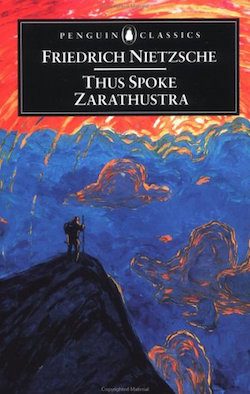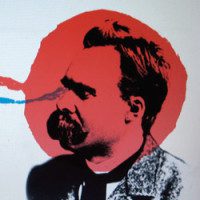In twenty years the physicist has been obliged on three or four occasions to rebuild his reason from scratch and, intellectually speaking, refashion his life. It is essentially this shift of reason that has sustained science fiction and which science fiction represents with remarkable virulence: the fact that the world has not just been turned upside down, but traversed by a plurality of structures… Science fiction takes these changes of measure and of reference at their word. And one can say of this genre that it is born when it starts to describe, not future man, but the adventures of possible man or, more precisely, of possible reason.
–Blanchot, “On the Proper Use of Science Fiction”
A new species of philosopher is appearing, I venture to baptize these philosophers with a name not without danger in it. As I divine them, as they let themselves be divined—for it pertains to their nature to want to remain a riddle in some respects—these philosophers of the future might rightly, but perhaps also wrongly, be described as attempters. This name itself is in the end only an attempt and, if you will, a temptation.
–Nietzsche, Beyond Good and Evil
PROLOGUE: THE ADVENTURES OF POSSIBLE MAN
In the summer of 1957, the critic William Empson wrote “Donne The Space Man,” an essay in which he recovers John Donne as an avid visionary of outer space. But before elaborating on his far-out theories, Empson issued a word of scholarly warning: “One does not particularly want, then, to have Donne keen on space travel unless he had a serious reason for it.”
READER: Why do you make Nietzsche so keen on space travel?
NIETZSCHE: What is it that makes you, dear reader, need Reason so keenly?
When asked for his “serious” reason for space-travel, Nietzsche began to laugh. It was a laughter that shattered all the familiar landmarks pointing to earth, and caused an earthquake that shook all of the ordered surfaces of the planets, and its aftershocks have since overturned cities and blasted mountain ranges out of ocean. And in the valleys of these mountains one can still hear the echoes of his laughter.
His books are full of these mountaintops. That is why they are so difficult to climb.
THE TRIAL
What is being attempted here is a series, in a somewhat particular order, of experiments.
The aphorism, unlike the polemic, is very suggestive. The idea is to try out many things, in the hopes of catching something, anything, plant or ghost.
The aphorism is always in flight, flying, shifty. Its thoughts must travel lightly, as the saddest leaves of grass, without the baggage of history or quotations.
On trial is Nietzsche’s philosophy of the future.
NIETZSCHE: Do you think this work must be fragmentary because I give it to you (and have to give it to you) in fragments?
BEYOND ALL BOOKS
Nietzsche’s books are a series of experiments, testing sites, laboratories: they test what is possible to think, what might one day be possible to think, and how he hoped to come into the possibility of thinking it.
As in the genre of science fiction, Nietzsche deals less in the certainty of established facts and more in kinds of knowledge still in states of formation.
His philosophy sleeps in fiction and dreams of science.
But when is science a fiction? And fiction a science? When is philosophy literary? Science philosophical?
Is what we find so baffling, so “difficult,” so unthinkable about Nietzsche his strange synthesis and reduction of these phases?
His intra-galactic polemics and his experimental parables defy not only thinking, but also prior structures of thought. Philosopher Avital Ronell formulates Nietzsche’s “unthinkable” thoughts thus: “Nietzsche offers a model for cognition that cannot simply account for itself or maintain its results within the assured certitudes of a controlled system of knowledge. At some level, the correlated acts of discovery and invention exceed the limits of what is knowable or even… strictly recognizable.”
He is, in other words, far out.
The Greek etymology of aphorism: apo—orizo… “out of… the horizon.”
Nietzsche writes from beyond, from out of the horizon by writing on the limit of the horizon itself.
OUT OF THE HORIZON
Nietzsche often uses the word Versuchen. To try. Trial.
 The aphorism is one such test site—especially for testing the extremities of language or how to escape from thought, or from the self.
The aphorism is one such test site—especially for testing the extremities of language or how to escape from thought, or from the self.
The aphorism is punctuation for the moment of insight itself. The éclat, a lightning flash.
Nietzsche’s body of work is made up of these momentary insights. The trajectory of the aphorism’s flight, lacking the guidance positioning systems of larger ballistic missiles, often misfires.
At one point, Nietzsche likens his aphorisms to a dance whose steps only great men may follow.
No wonder Nietzsche scholars have often accused each other of not understanding what he’s saying.
Which is also the point: his failure to consistently cohere into meaning is part of his necessarily contingent project.
The empiricist challenges the skeptic: Show me! Nietzsche’s figure of the gay scientist challenges them both: Try me.
The results of his testing can be guessed at but they cannot be known with certainty.
For the only thing we know for certain about the future is that we know nothing.
And aren’t they, after all, who Nietzsche says he is writing to—to philosophers of the future?
So who, then, is the philosopher of the future, this new man?
ON THE QUESTION OF ADDRESS
What does it mean to write books addressed “to the philosophers of the future,” “for free spirits”?
Interested in the problems of address, Nietzsche makes address a problem.
He wants to challenge ideas of reception and receptivity. Of what you can and can’t take with you. Who is posing the question? To whom? How far can an idea travel without meeting resistance, without gravity? Why do some ideas take flight?
“If we are prepared only now to receive his version of the question concerning technology,” writes Ronell, one of his avid receivers, it is “because he ran it along the lines of a delay call-forwarding system. He made us wait, holding back the scientific punch he wanted delivered.”
His contemporary reader is always a surrogate, a present approximation of a distant future tense.
To read Nietzsche in December 2015 is still too read him too soon. The ideal reader of Nietzsche would not need to read Nietzsche. No wonder Nietzsche’s relationship to his text’s mode of address is so antagonistic.
His philosophy will only be read until man overcomes himself. His experimentally open set, in this respect, has a strangely curved point of closure: at the limit of until.
But Nietzsche will address man until there is no man left to address. Nietzsche writes eschatology premised not on the death of a single man but on the death of the entire species. This is the upper limit of his future.
It is as though Nietzsche not only asks to be read posthumously but also that his readers are unborn.
Perhaps this mode of address is due to the impossibilities presented by not-thinking, by thinking nothing. Certainly it’s easier to imagine yourself shaking the hand of everyone at your funeral than to imagine yourself dead.
Nietzsche, being the first philosopher of the future, was also the last. Otherwise he was not Nietzsche.
THUS SPOKE SCIENCE FICTION
In his essay “On the Proper Use of Science Fiction,” the French philosopher Maurice Blanchot discussed some of the novel elements in science fiction’s emergence as a genre. He views science fiction as a “system of consequences which, at a certain moment, introduces the impossible and provokes a crisis, a rupture in the human condition and human truth such as we are accustomed to experiencing them.”
“It is an essentially intellectual exercise,” he continues, “whose research always calls into question whatever we happen to take for granted.” Which is also, of course, the goal of Nietzsche’s critique.
Nietzsche’s critique of knowledge rests partly on unraveling the way time is used as an instrument for control.
History labels all past “error” in the interest of progress and the preservation of the species, Nietzsche says. But this past error is produced by the same method we now call knowledge. Knowledge is simply the optimization and ossification of custom.
NIETZSCHE: After all, philosophers typically take “a conjecture, a whim, an “inspiration” or, more typically, they take some fervent wish that they have sifted through and made properly abstract–and they defend it with rationalizations after the fact.
It is often said that who controls the past controls the future but Nietzsche is one of the first to anticipate the power of speculation—that he who controls the future, controls the present.
 Heidegger suggests that because Nietzsche’s work is so untimely “no prior, mediocre human being”—a statement that holds for Nietzsche himself—could have thought it. It is for this reason that Nietzsche creates “the thinker of [these thoughts]” before he can yet approach them. “The communication of the thought most difficult to bear [i.e. the eternal return] … first of all requires the poetic creation of the figure who will think this thought [viz., Zarathustra].”
Heidegger suggests that because Nietzsche’s work is so untimely “no prior, mediocre human being”—a statement that holds for Nietzsche himself—could have thought it. It is for this reason that Nietzsche creates “the thinker of [these thoughts]” before he can yet approach them. “The communication of the thought most difficult to bear [i.e. the eternal return] … first of all requires the poetic creation of the figure who will think this thought [viz., Zarathustra].”
Nietzsche’s Thus Spoke Zarathustra, composed of sermons in miniature, creates Zarathustra, an alien “beyond one’s time” to teach us how to “overcome” this time in ourselves.
The quasi-novel starts out in a secular world similar to those in the Doomsday sci-fi genre, characterized by the critic Raymond Williams as a society “that used to have a God; it has none now.” With the philosopher’s “God is dead” premise thus assumed, Zarathustra asks us to imagine, “Now what?” He replies: now that we have overcome God, we must overcome man himself.
BACK TO THE FUTURE
Nietzsche described difficult problems like cold baths—you want to exit them as quickly as you enter. Keeping this in mind, it’s time to trace some of his difficult problems quickly. In flashes.
Throughout Nietzsche’s work three concepts recur: the will to power, the overman [Übermensch] and the eternal return.
The will is always striving. It cannot be satisfied by anything. The will is like the futurist’s conception of the bicycle—a machine that symbolized an infinite capacity for perfectibility. Earthly humans, limited by forces and gravity, can never ride the bicycle perfectly according to Nietzsche. There will always be some friction, some force against which they must struggle. There will always be time.
For the purpose of this experiment one can view the Overman and the eternal return as two companion myths, adult fairy tales, which bring out some of the temporal inflections of this boundless will. It is significant that Nietzsche turns to fiction, to the fable, to express ideas that cannot be otherwise narrated. If the aphorism is the form of his futurology, then the Overman and the eternal return are his “thought experiments.” And, as in most good experiments, their variables are also dependent on time.
It is no accident that Nietzsche the takes the perspective of someone far out in the future, far from the blue marble, in order to imagine, in the light-years of the stars, those eternities before the human intellect ever existed:
Once upon a time, in some out way corner of that universe which is dispersed into numberless twinkling solar systems, there was a star upon which clever beasts invented knowing. That was the most arrogant and mendacious minute of “world history,” but nevertheless, it was only a minute. After nature had drawn a few breaths, the star cooled and congealed, and the clever beasts had to die.—One might invent such a fable, and yet he still would not have adequately illustrated how miserable, how shadowy and transient, how aimless and arbitrary the human intellect looks within nature.
Logic, history, metaphysics, ethics, the nation-state—these lead man toward Civilization, away from space. One might say that Nietzsche went far out to space to probe and find man.
PARABLE I (STRAIGHT LINE)
The [Übermensch] represents the man beyond the all-too-human. He is beyond the last point in linear, evolutionary time.
But there is also sense in which the Overman parodies those who interpret Darwinian evolution as a redemptive promise, as the final proof of the Enlightenment’s faith in progress. Nietzsche parodies the naïve expectations of certain evolutionary ideologues in Thus Spoke Zarathustra:
All beings so far have created something beyond themselves… What is the ape to man? A laughingstock or a painful embarrassment. And man shall be just that for the overman: a laughingstock or a painful embarrassment… Once you were apes, and even now, too, man is more ape than any ape.
If it is not man, his narcissism now reduced to apish features, who is the measure of all things but, in fact, future man upon whom we project so many dreams, then we cannot redeem the past. Man, in light of the Overman, becomes a shameful laughingstock. There will always be more progress to progress to, to want to will. The effect of reading the Overman not as a genuine future aspiration but as a symbol of the negative aspects of the logic of futurity is that he becomes figural—and also satirical.
This is where the experiment of the Eternal Return enters.
PARABLE II (STRANGE LOOP)
Nietzsche’s perverse version of a sci-fi time machine is The Eternal Return. The Eternal Return forces us to consider, as novelist Milan Kundera has put it, what happens if “everything recurs as we once experienced it, and that the recurrence itself recurs ad infinitum!” But if one is doomed to forever repeat everything, then what?
Nietzsche puts teleology to the test with his suggestion of eternal return: if this moment really is so great, so progressive, would you be willing to endure it endlessly? Regressively?
No wonder Nietzsche calls this experiment of eternally bearing our own weight “the heaviest of burdens.”
“We are at bottom grave and serious human beings,” Nietzsche writes, “—really more weights than human beings.”
So heavy, and so burdened with this heaviness, he wonders if we might be better off annihilated? Nietzsche leaves readers with a choice between nihilism and affirmation.
The Eternal Return, then, is also an allegory for an attitude toward time itself.
FROM PREACHER… TO PROPHET
ZARATHUSTRA: “The time is coming…”
The prophet, as defined by Blanchot:
The prophets do not just foretell what is to come, they are the voice of what cannot be and is nonetheless coming and, by this coming, makes the present impossible. The prophets of science fiction have inherited the fascinating exigency of eschatology. Through them, we are constantly warned that something will come to pass that is unsurpassable in its extremity: a leap will be made, the end draws near, the limit is there. “The sky is dead”, says Campbell. Such is the impatience characteristic of the prophet, who cares only for what lies at the farthest remove.
This “impatience” that Blanchot puts his finger on is the tone of Zarathustra’s prophecy—and its limit.
The sky is dead, says Campbell. God is dead, says Zarathustra.
 “Science fiction,” Blanchot continues, “belongs neither to science, nor to aesthetics, nor to philosophy. It is something else entirely, in which one can recognize… a remarkable expression of the prophetic function.”
“Science fiction,” Blanchot continues, “belongs neither to science, nor to aesthetics, nor to philosophy. It is something else entirely, in which one can recognize… a remarkable expression of the prophetic function.”
After all, science fiction amazes not because it comes true but because it can come true.
Perhaps this is the most amazing feature that is achieved by the tone of Zarathustra: it is prophetic while refusing to specify its prophecy.
Nietzsche (or Nietzsche’s double, Zarathustra) is not a normative prophet of what should be but a prophet of prophecy itself.
A prophecy that represents the possibility of representing possibility.
Cleverly, Nietzsche doesn’t show readers his overman, his provocation to overcome thinking.
This is because the Overman is fundamentally incommunicable to those who are not already “over” man. “How can the advent of a world that is radically alien, a future that is absolutely futural,” asks Blanchot, “be communicated?”
The figure of Zarathustra foregrounds the impossibility of translating untimely thoughts.
This is why the book is a series of proposals and failures, of mistranslations, misfires, attempts, trials.
The reader remains outside Nietzsche’s texts not only because of a present misunderstanding but also because the present, by virtue of being such, necessitates such a misunderstanding.
“A Book For All and None,” Zarathustra‘s subtitle, is a literal description of the book’s relationship to the character of ‘the audience.’
And yet, it is this alterity—this misunderstanding, and Nietzsche’s need to be misunderstood—that gives a reason for the text’s existence in the first place.
Thus Blanchot: “News from the year ten thousand will get through to us only to the extent that it is translated back into our own ways of life.”
Only an alien, a wanderer of the future could read the chronicles of Zarathustra, this weird voyager.
A SPACESHIP CALLED ABDUCTION
Coined by 19th century American philosopher Charles Peirce, abduction is often pitched as a “third way” of reasoning, defined by what it is not: neither the Scylla of induction, nor the Charybdis of deduction. Abduction, rather, explains present phenomena by guessing at what may have occurred in the past. Abduction, in other words, is a means of determining the course to steer one’s ship through seas of contingency.
An essay on “regimes of anticipation” in the journal Subjectivity glosses abduction as a method for shuffling time: a telescoping of the future into the present. The labor of abduction, its authors write, is “a state of being… that involves tacking back and forth between the past, present and the future… [Abduction] is the labor of living in anticipation, of being out of time.”
Abduction, this “third way,” can help to answer the question of how Nietzsche’s prophecy mgiht be made visible, or manifest itself, in the present.
At once empirical and abstract, abduction’s “tacking back and forth between the past, present and future” can provide escape routes from the future by sabotaging the sanctity of the present.
Abduction not only sabotages time, like Nietzsche, but also, like Nietzsche, sabotages norms. “Abduction,” they explain, “thrives in the vibrations between the is and the ought, consummately modern yet augmented by anticipation in ways that undermine the certainties on which modernity thrives.”
Nietzsche’s ghostly anticipations, nauseating abductions, quivering vibrations, and dizzying leaps disturb and kidnap anyone’s purchase on the future.
If Nietzsche’s preacher-prophet, his he-who-anticipates, teaches us anything, it is a way of being in which one “inhabits time out of place as the future.” Isn’t this what the Eternal Return—an experiment that forces us to revaluate our conception of the present by reshuffling of our attitude towards the past—teaches too?
Part of Nietzsche’s project is to force readers to make demands of the present. But it is only possible to work on the present by hailing imaginaries to help us perceive its alien futures.
The work of abduction, in Nietzsche, is embodied by his aphorisms: his flashes make the reader perform the shuffling and stitching and reweaving between alternate and contingent time zones. Unlike the sheared sentences and hedged paragraphs of hypotactic prose (with all of its guideposts and signifying topiary), bundles of aphorisms (such the entirety of The Gay Science) never guide the reader toward absolute meaning.
Out of joint, the arrows of the aphorism point every which way. They are as cryptic as they are elucidating. They cause us to take leaps, to leap without faith, to be daring, to dare—above all, to live dangerously.
As for Nietzsche, he had the most serious reason for these space travels: not needing reason at all.




